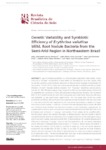Por favor, use este identificador para citar o enlazar este ítem:
http://www.alice.cnptia.embrapa.br/alice/handle/doc/1062237Registro completo de metadatos
| Campo DC | Valor | Lengua/Idioma |
|---|---|---|
| dc.contributor.author | MENEZES, K. A. S. | pt_BR |
| dc.contributor.author | ESCOBAR, I. E. C. | pt_BR |
| dc.contributor.author | FRAIZ, A. C. R. | pt_BR |
| dc.contributor.author | MARTINS, L. M. V. | pt_BR |
| dc.contributor.author | FERNANDES JUNIOR, P. I. | pt_BR |
| dc.date.accessioned | 2017-01-31T11:11:11Z | pt_BR |
| dc.date.available | 2017-01-31T11:11:11Z | pt_BR |
| dc.date.created | 2017-01-31 | pt_BR |
| dc.date.issued | 2017 | pt_BR |
| dc.identifier.citation | Revista Brasileira de Ciência do Solo, v. 41, p. 1-13, 2017. | pt_BR |
| dc.identifier.uri | http://www.alice.cnptia.embrapa.br/alice/handle/doc/1062237 | pt_BR |
| dc.description | Legume-rhizobia symbiosis is a cross-kingdom association that results in large mounts of nitrogen incorporated in food webs. For the Brazilian semi-arid region, data on genetic variability and symbiotic efficiency of Papilionoidae rhizobial communities are very scarce. The aim of this study was to evaluate the genetic variability and the symbiotic efficiency of eight rhizobial isolates obtained from ?mulungu? (Erythrina velutina Willd.) nodules. For 16S rRNA gene sequencing, the genomic DNA was extracted using a commercial kit, amplified with universal primers, and subjected to sequencing reactions. For the isolate ESA 71, PCR amplifications for nodC and nodA genes were attempted. Rhizobial efficiency was assessed by two greenhouse experiments. The first assay was carried out under gnotobiotic conditions, with sterile sand as a substrate; the second experiment was conducted in a non-sterile soil. For both experiments, the inoculation treatments consisted of a single inoculation of each isolate, in addition to a treatment with Bradyrhizobium elkanii BR 5609 as a reference strain. Furthermore, two non-inoculated control treatments, supplied and not supplied with mineral N, were also evaluated. Bacterial identification indicated that both and rhizobia could be found in ?mulungu? root nodules. Three isolates where classified within the Rhizobium genus, four bacteria belonged to Bradyrhizobium and one isolate clustered with Burkholderia. Positive amplification of an intragenic fragment of the nodA gene using a primer set to ?-rhizobia could be found for ESA 71 (Burkholderia). All bacterial isolates were effective in colonizing ?mulungu? roots. In the first experiment, all inoculated treatments and N fertilization increased the N concentration in ?mulungu? shoot tissues. For total N in the shoots, the isolates ESA 70, ESA 72, and ESA 75 stood out. In the non-sterile substrate experiment, the isolates ESA 70, ESA 71, ESA 72, and ESA 75, together with the reference strains, induced increases in the shoot N concentration and total accumulation compared to the absolute control. The results indicate that ?mulungu? is able to establish associations with efficient ? and ?-rhizobia in Brazilian semi-arid soils. | pt_BR |
| dc.language.iso | por | pt_BR |
| dc.rights | openAccess | pt_BR |
| dc.subject | Fixação biológica de notrogenio | pt_BR |
| dc.subject | Leguminosa arbórea | pt_BR |
| dc.subject | Planta nativa | pt_BR |
| dc.subject | Biological nitrogen fixation | pt_BR |
| dc.subject | Rizóbio | pt_BR |
| dc.subject | Variabilidade genética | pt_BR |
| dc.title | Genetic variability and symbiotic efficiency of Erythrina velutina Willd root nodule bacteria from the Semi-Arid region in Northeastern Brazil. | pt_BR |
| dc.type | Artigo de periódico | pt_BR |
| dc.date.updated | 2018-01-18T11:11:11Z | pt_BR |
| dc.subject.thesagro | Caatinga | pt_BR |
| dc.subject.thesagro | Mulungu | pt_BR |
| riaa.ainfo.id | 1062237 | pt_BR |
| riaa.ainfo.lastupdate | 2018-01-18 -02:00:00 | pt_BR |
| dc.contributor.institution | KELLY ALEXSANDRA SOUZA MENEZES, Universidade do Estado da Bahia, Departamento de Tecnologia e Ciências Sociais; INDRA ELENA COSTA ESCOBAR, UNIVASF; ANA CARLA RESENDE FRAIZ, UNIVASF; LINDETE MÍRIA VIEIRA MARTINS, Universidade do Estado da Bahia, Departamento de Tecnologia e Ciências Sociais, Juazeiro, Bahia; PAULO IVAN FERNANDES JUNIOR, CPATSA. | pt_BR |
| Aparece en las colecciones: | Artigo em periódico indexado (CPATSA)  | |
Ficheros en este ítem:
| Fichero | Descripción | Tamaño | Formato | |
|---|---|---|---|---|
| pAULOiVAN2017.pdf | 822.41 kB | Adobe PDF |  Visualizar/Abrir |









